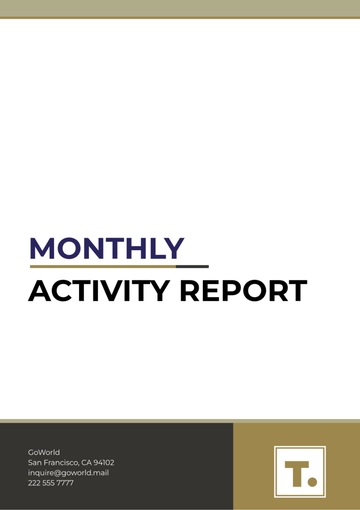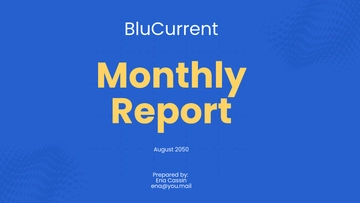Free Sales Monthly Training Report

I. Executive Summary
This report provides an in-depth review of all sales training initiatives carried out in [Month, Year]. The month saw the introduction of three distinct training programs, targeting new employees, skill enhancement, and sales strategies. The total budget allocated was $[Amount], out of which [95%] was utilized effectively. Overall, the programs witnessed a positive outcome, increasing the average closing ratio by [12%].
II. Introduction
The Sales Training Report for [Month, Year] aims to evaluate the effectiveness and impact of our training programs. This report provides insights into the training modules, budget allocation, and participant feedback. It serves as a tool for decision-makers to understand the ROI and plan for subsequent months. The introduction serves to familiarize readers with the purpose and content of the report.
III. Sales Training Programs
New Employee Onboarding
Duration: [Month, Day, Year]
Participants: [Number] new hires
Topics Covered: Company values, product knowledge, sales process, CRM tools
Highlights:
[90%] of the participants found the program "Very Useful."
[8%] increase in CRM usage among new hires
Participants displayed improved communication and understanding of the company culture.
This foundation aims to help new hires integrate seamlessly into their roles.
Skill Enhancement Programs
Duration: [Month, Day, Year]
Participants: [Number] Sales Executives
Topics Covered: Negotiation skills, objection-handling, upselling techniques
Highlights:
[12%] increase in average sales figures among participants
[85%] reported improvement in negotiation capabilities
Training involved real-life scenarios to practice skills.
Participants reported being more comfortable in handling objections after the training.
Sales Strategy Programs
Duration: [Month, Day, Year]
Participants: [Number] Sales Managers
Topics Covered: Strategic planning, pipeline management, team leadership
Highlights:
[20%] improvement in sales funnel efficiency
[10%] increase in team output
The program used interactive exercises to help managers plan strategies better.
An added focus was given to effective communication within teams.
IV. Program Outcomes and Feedback
Evaluation Metrics
Metric | Pre-training | Post-training | Percentage Improvement |
|---|---|---|---|
Average Closing Ratio | [50%] | [62%] | [12%] |
CRM Utilization | |||
Sales Funnel Efficiency |
Evaluation metrics are essential for quantitative assessment of the training programs. The data showcases a promising upward trend in key performance indicators.
Participant Feedback
Program Type | Very Useful | Somewhat Useful | Not Useful |
|---|---|---|---|
New Employee Onboarding | [90%] | [8%] | [2%] |
Skill Enhancement | |||
Sales Strategy |
Participant feedback serves as a qualitative measure of the programs' success. This will be essential in fine-tuning future programs to better meet participant needs.
V. Financial Overview
Budget Utilization
Total Budget: [$Amount]
Amount Utilized: [$Amount]
Unused Budget: [$Amount]
Effective budget utilization ensures maximized returns from the training programs. The unused budget will be rolled over to the next month’s training initiatives.
Return on Investment
ROI = (Net Profit / Cost of the Program) x 100
ROI for the month: [125%]
ROI serves as a critical indicator of the financial viability of the training programs. A positive ROI confirms that the programs are not just effective but also cost-efficient.
VI. Recommendations
Based on the success of the programs, the following actions are recommended:
Increase the budget allocation for Skill Enhancement Programs by [15%] for the next month.
Initiate a monthly feedback session for continual improvement.
These recommendations are designed to capitalize on the successes and learn from the challenges observed.
Implementing them can make future training programs even more effective.
VII. Conclusion
The Sales Training Programs for [Month, Year] have proven to be effective, as evidenced by the increase in key performance metrics and positive feedback from the participants. Budget utilization has been efficient, with an ROI of [125%]. In conclusion, the training initiatives not only achieved their goals but also provided actionable insights for future planning. The data and feedback collected from a valuable resource for refining future training initiatives.
- 100% Customizable, free editor
- Access 1 Million+ Templates, photo’s & graphics
- Download or share as a template
- Click and replace photos, graphics, text, backgrounds
- Resize, crop, AI write & more
- Access advanced editor
Enhance your sales team's performance with our Sales Monthly Training Report Template, conveniently available on Template.net. Track progress, measure effectiveness, and make data-driven decisions to boost sales results. The template is customizable and editable using our Ai Editor Tool so you can optimize your sales training efforts for maximum success!
You may also like
- Sales Report
- Daily Report
- Project Report
- Business Report
- Weekly Report
- Incident Report
- Annual Report
- Report Layout
- Report Design
- Progress Report
- Marketing Report
- Company Report
- Monthly Report
- Audit Report
- Status Report
- School Report
- Reports Hr
- Management Report
- Project Status Report
- Handover Report
- Health And Safety Report
- Restaurant Report
- Construction Report
- Research Report
- Evaluation Report
- Investigation Report
- Employee Report
- Advertising Report
- Weekly Status Report
- Project Management Report
- Finance Report
- Service Report
- Technical Report
- Meeting Report
- Quarterly Report
- Inspection Report
- Medical Report
- Test Report
- Summary Report
- Inventory Report
- Valuation Report
- Operations Report
- Payroll Report
- Training Report
- Job Report
- Case Report
- Performance Report
- Board Report
- Internal Audit Report
- Student Report
- Monthly Management Report
- Small Business Report
- Accident Report
- Call Center Report
- Activity Report
- IT and Software Report
- Internship Report
- Visit Report
- Product Report
- Book Report
- Property Report
- Recruitment Report
- University Report
- Event Report
- SEO Report
- Conference Report
- Narrative Report
- Nursing Home Report
- Preschool Report
- Call Report
- Customer Report
- Employee Incident Report
- Accomplishment Report
- Social Media Report
- Work From Home Report
- Security Report
- Damage Report
- Quality Report
- Internal Report
- Nurse Report
- Real Estate Report
- Hotel Report
- Equipment Report
- Credit Report
- Field Report
- Non Profit Report
- Maintenance Report
- News Report
- Survey Report
- Executive Report
- Law Firm Report
- Advertising Agency Report
- Interior Design Report
- Travel Agency Report
- Stock Report
- Salon Report
- Bug Report
- Workplace Report
- Action Report
- Investor Report
- Cleaning Services Report
- Consulting Report
- Freelancer Report
- Site Visit Report
- Trip Report
- Classroom Observation Report
- Vehicle Report
- Final Report
- Software Report





























